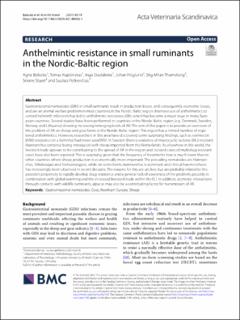Management Practices, Farmers' Knowledge of Diseased Fish, and Their Occurrence in Fish Farms in Nyeri County, Kenya
Mulei, Isaac Rumpel; Mbuthia, Paul G.; Waruiru, Robert M.; Nyaga, Phillip N.; Mutoloki, Stephen; Evensen, Øystein
Peer reviewed, Journal article
Published version
Permanent lenke
https://hdl.handle.net/11250/2786984Utgivelsesdato
2021Metadata
Vis full innførselSamlinger
Originalversjon
10.1155/2021/8896604Sammendrag
Gastrointestinal nematodes (GIN) in small ruminants result in production losses, and consequently economic losses, and are an animal welfare problem in most countries in the Nordic-Baltic region. Intensive use of anthelmintics to control helminth infections has led to anthelmintic resistance (AR), which has become a major issue in many European countries. Several studies have been performed in countries in the Nordic-Baltic region (e.g. Denmark, Sweden, Norway and Lithuania) showing increasing/emerging levels of AR. The aim of this paper is to provide an overview of the problem of AR on sheep and goat farms in the Nordic-Baltic region. This region has a limited number of registered anthelmintics. However, researchers in this area have discovered some surprising findings, such as ivermectin (IVM) resistance on a farm that had never used IVM. In Sweden there is evidence of macrocyclic lactone (ML)-resistant Haemonchus contortus being introduced with sheep imported from the Netherlands. As elsewhere in the world, the livestock trade appears to be contributing to the spread of AR in the region and isolated cases of multidrug-resistant cases have also been reported. This is surprising given that the frequency of treatments here is much lower than in other countries where sheep production is economically more important. The prevailing nematodes are Haemonchus, Teledorsagia and Trichostrongylus, while on some farms Haemonchus is dominant and clinical haemonchosis has increasingly been observed in recent decades. The reasons for this are unclear, but are probably related to this parasite’s propensity to rapidly develop drug resistance and a general lack of awareness of the problem, possibly in combination with global warming and the increased livestock trade within the EU. In addition, domestic interactions through contacts with wildlife ruminants, alpacas may also be a contributing factor for transmission of AR.
